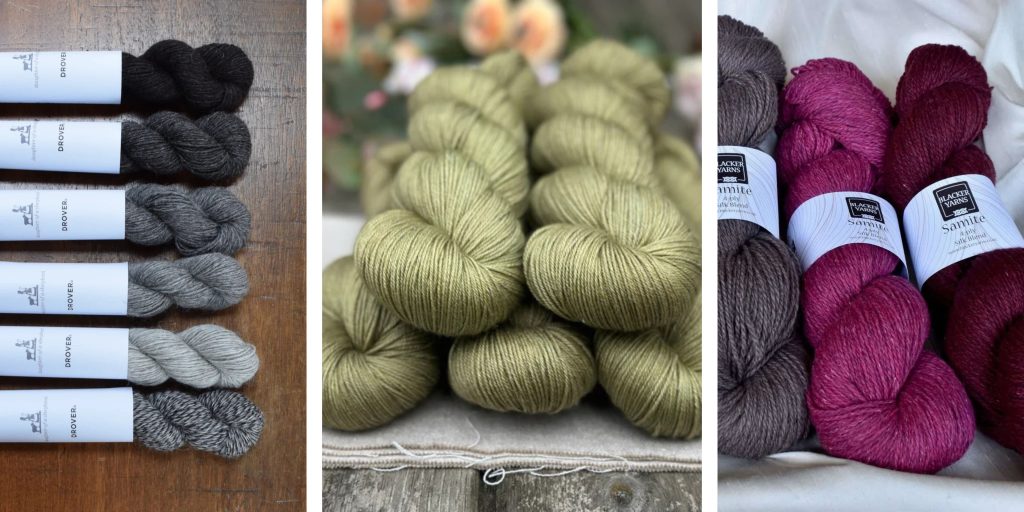My attitude to sustainability, in terms of both my knitting and clothing in general, snuck up on me to be honest. One minute I was happily casting on a ribbed beanie with a half-price acrylic blend. The next, I was squinting at care labels in the fitting room like some kind of wool detective. These days, every shop-bought knit gets mentally deconstructed: could I make it? Would I want to? Is the yarn ethical, or is it secretly 90% plastic and empty promises?
What started with my handknits has spilled into the rest of my wardrobe too – jeans, t-shirts, socks (yes, even the underwear drawer isn’t safe). If I’m not making it, I want to know who did, how and why. It’s developed into a practice of curiosity and care. Like knitting itself, really.
It’s got me thinking about the ways in which we can extend our sustainability to all the different elements of knitting as a hobby – the sourcing of yarn (both in terms of fibre and the purveyor), the making of the garment, all the way through to the long-term care and potential recycling. And here’s what I came up with…
1. Knit for longevity
The thing about fast fashion is it’s built to be temporary. Wear once, wash poorly, bin unceremoniously. But when you’re the one who’s spent the better part of a month (or two) working up a raglan sweater, you don’t chuck it in the charity bag after a year.
So it might be better to choose timeless shapes. That saddle-shoulder jumper might not be trending on Instagram this week, but it’ll still be gorgeous when everyone else’s puff-sleeve experiment is yesterday’s news. And with trend-led knitting creeping in more and more, it’s so tempting to cast on whatever’s in the latest pattern drop. I have to stop myself sometimes and ask: would I really wear this? Not just once for a photo, but over and over again, happily, with half my wardrobe. If the answer’s a hesitant “maybe,” the needles have to stay put.
And finish well. While kitchener stitch is a faff, do it anyway. Your future self will thank you, as will the seams.
2. Mind the (energy) gap
Let’s talk lightbulbs and laundry. With knitting, sustainability extends to how you do it. Knitting in natural daylight is a small pleasure that also happens to lower your footprint. Bonus: yarn colours look more honest in sunlight. You might think that skein is terracotta under your overhead lamp. It’s rust. Accept it. And if you’ve ever tried knitting dark colours by lamplight, you’ll know how much eye strain that causes!
When it comes to caring for your makes, treat them like houseplants: gentle, no tumble-drying, and ideally kept out of direct sun. I personally love handwashing my knits. I’ve somehow tricked my brain into thinking it isn’t a chore, but a mindfulness practice (my mum says she finds ironing therapeutic and I roll my eyes, so I totally get how strange I seem). I get a quiet joy out of caring for my knits. Plus, fewer microplastics in the water system. Everybody wins.
3. Gifting sans the guilt trip
Here’s the thing. Not every handknit has to be a gift. And not every gift has to be handknit. Ask before you knit. Or, if that ruins the surprise, at least check they’re into chunky cowls before you spend three nights entwined with alpaca.
Intentional gifting = less landfill. And fewer awkward conversations about “why I never see you wearing that jumper I made.”
4. Think circular with your knitting
If you’re anything like me, you’ve got a drawer full of “maybe one day” swatches and abandoned projects. Let’s not talk about my frogged mohair jumper from 2021. I’ll turn it into something else someday. But the point is circular thinking means those bits don’t go to waste. We don’t just think about biodegradable yarn, we need to knit with the future in mind.
Could that toddler jumper become a tank top in a few years? Could your scarf one day be reknit into wristwarmers? I’m all for reinvention and evolution. I’ve already got a stack of my son’s knits that he’s outgrown (I’m not crying, you are!). And when I get over the emotional trauma of him growing up so fast I’ll either regift them or frog them back into something new. Like a phoenix, but with more merino!
5. Consciously source your yarns
Now we’re getting to the juicy bit: yarn shopping but with morals. I know this is dangerous territory. But this is where the real change happens.
Start with the locals. Depending on where you’re based it will look different. For me that looks like this:
Daughter of a Shepherd’s flock are practically knitting royalty at this point, grazing native pastures and spinning up wool that smells faintly of the Yorkshire Dales (in the best way). Blacker Yarns keep heritage breeds alive and well, and honestly, their Merino is dreamy. And then there’s Eden Cottage Yarns – a Yorkshire-based dyer whose soft, muted palette feels like the British countryside in skein form. Their colours have that gentle, timeless quality that makes you want to knit a whole jumper just to live inside them. Particular favourites are their Hayton and Titus bases.
Further afield, Knitting for Olive and Along Avec Anna are keeping things low-impact and socially kind, and their number of shades means they literally have something for everyone.
Basically, if you’re going to spend £18 on a skein, make it one that pays its farmers fairly and doesn’t trash the planet. Win-win.

6. Make it work harder for you
Here’s a wild idea: what if your knitting could adapt with you? Removable sleeves, modular panels, waistbands you can tweak when the biscuits hit back, sustainability goes way beyond fibre, it can also be about fit for the long-term.
I’ve started thinking about this the same way fashion folks talk about capsule wardrobes. Except mine involves toggles, short rows and the occasional swear word when I miscount my increases. Still. If your jumper can be worn three ways and still looks chic with pyjama bottoms? That’s peak cost-per-wear knitwear.
Useful resources
If you’ve ever fallen down a rabbit hole of fibre research (just me?), these are brilliant starting points for digging into the “why” behind sustainable yarn choices.
- Textile Exchange – An industry-leading non-profit that tracks the environmental impact of fibres worldwide. Their annual report is a goldmine if you want to see how wool, cotton and synthetics compare in terms of climate, water and biodiversity impact.
- Common Objective: Fibres & Fabrics Hub – A clear, accessible guide to the pros, cons and footprint of different fibres. A great one for knitters who want to understand exactly what “organic,” “recycled,” or “biodegradable” really mean when it comes to the yarn they pick.
- Fashion Revolution – Not knitting-specific, but this global movement pushes for transparency and fair treatment across the fashion supply chain. Their resources can inspire the same level of curiosity and accountability when choosing your yarn.
Your turn
Maybe these are all tactics you’ve been quietly following for years. Or maybe you’re just beginning to think about sustainability in your knitting and wondering where on earth to even start. Either way, I hope these pointers have given you something to consider and at the very least I hope it reassures you that yes, small shifts do matter. Ultimately it’s not about being perfect, and we all have to start somewhere.
Have you got any go-to yarn suppliers doing good things in the world? Or a clever trick for designing adaptable knits or giving your projects a second life? There’s a lot to be said for building a long-lasting handmade wardrobe. I’d love to hear your thoughts!
Beth x

